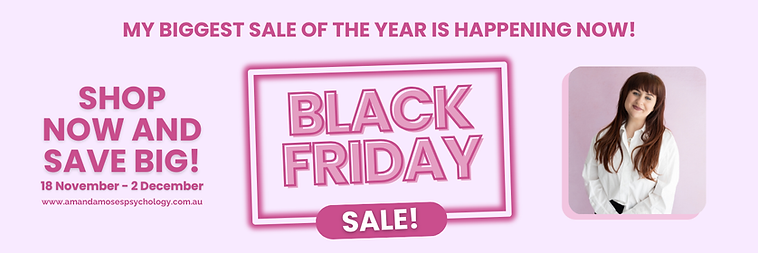Treatment Planning for AuDHD Clients: Moving Beyond the Manualised Model
- Amanda Moses Psychology

- Jun 17
- 4 min read
Treatment planning can feel straightforward on paper—especially if you’re following a structured, manualised model. But when you're working with clients who are both autistic and ADHD (often referred to as AuDHD), those models often fall short. Why? Because they were never designed with neurodivergent brains in mind.
Rigid step-by-step protocols may sound good in theory, but in practice, they can feel overwhelming, inaccessible, or even invalidating for many AuDHD clients. AuDHD clients often need something more dynamic, more collaborative, and far more flexible.
Let’s talk about how to rethink treatment planning for AuDHD clients—so therapy can actually work with their brain, not against it.

Understanding AuDHD: A Quick Refresher
AuDHD refers to individuals who are both autistic and ADHD. These neurotypes intersect in unique ways—sometimes amplifying particular traits, and sometimes creating internal contradictions that make life (and therapy) particularly challenging.
For example:
A client may crave routine (autistic trait) but struggle to implement one due to challenges with executive functioning (ADHD trait).
They might have struggles with emotional reactivity and managing emotional impulses (ADHD trait) and find it difficult to articulate those feelings in session (autistic trait).
They may desperately want to recharge alone (autistic trait), but the ADHD drive for stimulation doesn’t allow them to slow down.
Understanding this internal push-pull dynamic is essential when building effective treatment plans. An AuDHD client not following through on tasks is not necessarily “resistant” or “unmotivated”—it may be that the plan wasn’t designed with their brain in mind.
Key Principles for Treatment Planning with AuDHD Clients
1. Build Flexibility into the Framework
Allow space for non-linear progress. Your client may have weeks where they make huge gains, followed by periods of shutdown, burnout, or a decline in executive dysfunction. The plan needs to accommodate variability, but also ensure we are teaching our AuDHD vital pacing strategies.
It is also important to expect and normalise task switching and inconsistency. Instead of rigidly sticking to a session structure, use a shared agenda at the start and co-create session goals. Allow some space for “where their brain is at” today, while still maintaining continuity of care over time. Having a routine and consistency will make the session flow easier, and ensures we are honouring their needs.
2. Use Special Interests and Dopaminergic Hooks
Many AuDHD clients engage best when therapy taps into their curiosity or special interests. Use these as entry points—not rewards.
For example:
If a client is passionate about animals, find a way to incorporate their special interest when providing psychoeducation or doing therapy work (yes, with adults too.)
If they enjoy gaming, build in language around “levelling up” or “side quests” to make tasks feel more accessible.
3. Plan for Executive Dysfunction
Don’t just assign homework—plan for how the client will remember, initiate, and complete it.
✔ Can you set reminders together?
✔ Is there a visual template or worksheet that would help?
✔ Would a voice memo instead of a written journal entry be more achievable?
✔ Is the therapy homework actually compatible with their executive functioning challenges? ✔ How can you make it more accessible and not add to their overwhelming pile of ‘to do’s’?
Executive functioning management strategies will not just be a therapy goal, but needs to be modelled within your therapy too.
4. Focus on Interoception and Energy Management
Some AuDHD clients struggle to notice internal cues until they’re in a state of overwhelm or shutdown. This is particularly important for your clients who may have Alexithymia, or lower interoceptive awareness. Treatment planning should include education and practice around interoception, pacing, and rest.
You might collaboratively build:
Energy mapping tools
Sensory audit activities
“Traffic light” systems to flag early signs of overload
I have included some of these and worksheets you can use with your clients in my resource: ADHD Management Strategies and Interoceptive Awareness and Regulation.
5. Building a Positive Identity
Working with neurodivergent clients should always include goals around helping them build a positive sense of self.
This may include things like:
Exploring their neurodivergent identity
Psychoeducation about their neurotype from an affirming framework
Highlighting both strengths and challenges
Giving them a safe space to be their authentic self
Learning how to advocate for themselves
Final Thoughts: Make Therapy Work With the Brain, Not Against It
Working with AuDHD clients is deeply rewarding—but it requires flexibility, creativity, and a willingness to unlearn what we’ve been taught about what therapy is “supposed” to look like.
The goal isn’t to fix or normalise, but to co-create a space where clients can build skills, deepen insight, and feel genuinely supported in a way that works for them.
Want More Support with Neurodiversity-Affirming Practice?
If this post resonated with you and you're ready to upskill, my Neurodiversity-Affirming Therapy training dives deep into:
✔ The essentials of neurodiversity-affirming practice
✔ Practical adaptations for working with autistic and ADHD clients
✔ An overview of common presenting problems in AuDHD clients—and affirming strategies that work
This training is perfect for psychologists, therapists, and mental health professionals looking to move beyond generic CBT and build genuinely affirming, effective therapy for neurodivergent clients.







